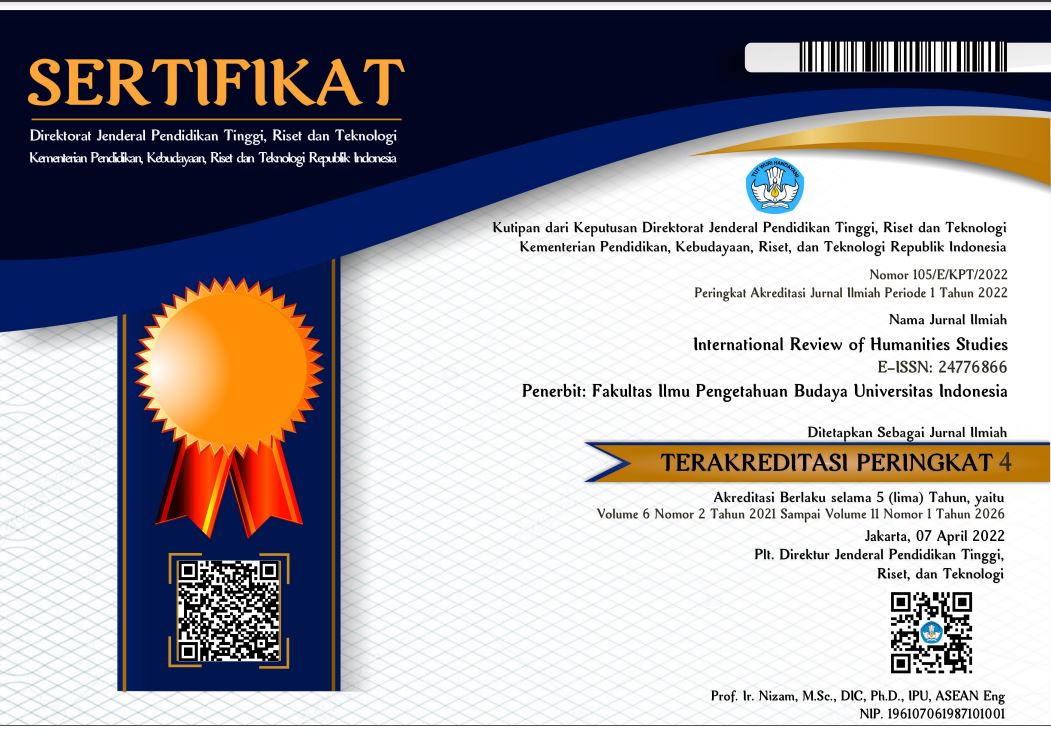International Review of Humanities Studies

Abstract
The fortress in the 20th century has certain characteristics to match the war strategy that is applied at this time. In 1900 the Kustbatterij Kedoeng-Tjowek project or Kedung Cowek fortress was built as a coastal defense for the city of Surabaya by the Dutch colonial. This study aims to identify the function of each building contained in the Kedung Cowek fort military area using a component review by their availability and categorization. Based on the analysis results it is known that each building has a specific function related to the concept of panopticon to apply the value of surveillance in its defense system.
References
Abbas, Novida (2001). Dutch Forts of Java: A Locational Study. Singapore: National University of Singapore (Thesis).
Abbas, Novida (2018). Beberapa Benteng Belanda di Jawa Tengah. Yogyakarta: Balai Arkeologi Yogyakarta.
Abrianto, Octaviadi (2008). “Perkembangan Teknologi Bangunan Pertahanan sebelum dan setelah Abad 20 Masehi di Indonesia”. in Dinamika Permukiman dalam Budaya Indonesia (page 107-122). Banten: Ikatan Ahli Arkeologi Indonesia.
Abrianto, Octaviadi (2011). “Batterij Antjol Permasalahan dan Saran Pemecahan Masalah”. in Arkeologi Peran dan Manfaat bagi kemanusiaan (page 68-81). Bandung: Alqaprint
Alwi, Des, (2012), Pertempuran Surabaya November 1945. Jakarta: Bhuana Ilmu Populer.
Batara Hutagalung, (2001), 10 November ’45, Mengapa Inggris Membom Surabaya? Jakarta: Millenium Publisher.
Bozovic, Miran, (1995). Jeremy Bentham: The Panopticon Writings. London: Biddles Ltd.
Clarke, David, L, (1977), Spatial Archaeology. London: Academic Press.
Djamhari, Saleh As’ad, (2003), Strategi Menjinakan Diponegoro: Stelsel Benteng 1827-1830.
Jakarta: Yayasan Komunitas Bambu.
Foucault, Michel, (1977), Discipline and Punish: The Birth of the Prison. New York: Pantheon Books.
Hogg, Ian, (1981), The History of Fortification. London: Orbis Publishing.
Indrawan, Angga. (2017), Napak Tilas Jalan Deandels. Jakarta: Buku Republika
Koestoro, Lucas Partanda (2013). “Benteng di Sumatera Bagian Utara dan Perspektif penelitiannya”. in Benteng dulu, kini, dan Esok. Yogyakarta: Balai Arkeologi Yogyakarta.
Mansyur, Syahrudin (2014). Sistem Perbentengan Dalam Jaringan Niaga Cengkih Masa Kolonial Di Maluku. Ambon: Balai Arkeologi Ambon.
Manokha, Ivan (2018). Surveillance, Panopticism, and Self-Discipline in the Digital Age Oxford: Oxford University, UK.
Novita, Aryandini (2013). “Benteng Kuto Besak dari Keraton Hingga Instalasi Militer”. in Benteng dulu, kini, dan Esok. Yogyakarta: Balai Arkeologi Yogyakarta.
Randle, Lisa B (2011). Applying the Panopticon Model to Historic Plantation Landscapes through Viewshed Analysis. Columbia: Department of Anthropology at the University of South Carolina, Columbia.
Samidi (2017). “Surabaya sebagai Kota Kolonial Modern pada Akhir Abad ke-19: Industri, Transportasi, Permukiman, dan Kemajemukan Masyarakat”. in Mozaik Humaniora Vol 17. Surabaya: Universitas Airlangga.
Setyawan, Ady, (2015), Benteng-Benteng Surabaya. Yogyakarta: Mata Padi Pressindo.
Sharer, R J dan W. Ashmore, (2003), Archaeology Discovering Our Past. New York: McGraw-Hill Companies.
Suryohadiprojo, Sayidiman. (2008), Pengantar Ilmu Perang, Jakarta: Pustaka Intermasa.
Timan, Tjerk., Galič, Maša., & Koops, Bert-Jaap (2017). Surveillance Theory and its Implications for Law. Oxford: The Oxford Handbook of the Law and Regulation of Technology
Recommended Citation
Giffari, Rafli Ahmad
(2021)
"COMPONENT ANALYSIS AT FORT KEDUNG COWEK BUILDINGS IN SURABAYA, EAST JAVA: OBSERVATION ON PANOPTICON CONCEPT,"
International Review of Humanities Studies: Vol. 6:
No.
3, Article 9.
DOI: 10.7454/irhs.v6i3.1336
Available at:
https://scholarhub.ui.ac.id/irhs/vol6/iss3/9
Included in
Anthropology Commons, Art and Design Commons, Creative Writing Commons, Cultural Heritage Law Commons, Education Law Commons, Film and Media Studies Commons, History Commons, Intellectual Property Law Commons, International and Area Studies Commons, Legal Writing and Research Commons, Linguistics Commons, Museum Studies Commons, Philosophy Commons, Urban Studies and Planning Commons



